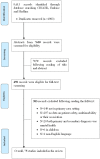Multimorbidity and Patient Safety Incidents in Primary Care: A Systematic Review and Meta-Analysis
- PMID: 26317435
- PMCID: PMC4552710
- DOI: 10.1371/journal.pone.0135947
Multimorbidity and Patient Safety Incidents in Primary Care: A Systematic Review and Meta-Analysis
Abstract
Background: Multimorbidity is increasingly prevalent and represents a major challenge in primary care. Patients with multimorbidity are potentially more likely to experience safety incidents due to the complexity of their needs and frequency of their interactions with health services. However, rigorous syntheses of the link between patient safety incidents and multimorbidity are not available. This review examined the relationship between multimorbidity and patient safety incidents in primary care.
Methods: We followed our published protocol (PROSPERO registration number: CRD42014007434). Medline, Embase and CINAHL were searched up to May 2015. Study design and quality were assessed. Odds ratios (OR) and 95% confidence intervals (95% CIs) were calculated for the associations between multimorbidity and two categories of patient safety outcomes: 'active patient safety incidents' (such as adverse drug events and medical complications) and 'precursors of safety incidents' (such as prescription errors, medication non-adherence, poor quality of care and diagnostic errors). Meta-analyses using random effects models were undertaken.
Results: Eighty six relevant comparisons from 75 studies were included in the analysis. Meta-analysis demonstrated that physical-mental multimorbidity was associated with an increased risk for 'active patient safety incidents' (OR = 2.39, 95% CI = 1.40 to 3.38) and 'precursors of safety incidents' (OR = 1.69, 95% CI = 1.36 to 2.03). Physical multimorbidity was associated with an increased risk for active safety incidents (OR = 1.63, 95% CI = 1.45 to 1.80) but was not associated with precursors of safety incidents (OR = 1.02, 95% CI = 0.90 to 1.13). Statistical heterogeneity was high and the methodological quality of the studies was generally low.
Conclusions: The association between multimorbidity and patient safety is complex, and varies by type of multimorbidity and type of safety incident. Our analyses suggest that multimorbidity involving mental health may be a key driver of safety incidents, which has important implication for the design and targeting of interventions to improve safety. High quality studies examining the mechanisms of patient safety incidents in patients with multimorbidity are needed, with the goal of promoting effective service delivery and ameliorating threats to safety in this group of patients.
Conflict of interest statement
Figures













Similar articles
-
Systemic pharmacological treatments for chronic plaque psoriasis: a network meta-analysis.Cochrane Database Syst Rev. 2021 Apr 19;4(4):CD011535. doi: 10.1002/14651858.CD011535.pub4. Cochrane Database Syst Rev. 2021. Update in: Cochrane Database Syst Rev. 2022 May 23;5:CD011535. doi: 10.1002/14651858.CD011535.pub5. PMID: 33871055 Free PMC article. Updated.
-
Interventions for improving outcomes in patients with multimorbidity in primary care and community settings.Cochrane Database Syst Rev. 2016 Mar 14;3(3):CD006560. doi: 10.1002/14651858.CD006560.pub3. Cochrane Database Syst Rev. 2016. Update in: Cochrane Database Syst Rev. 2021 Jan 15;1:CD006560. doi: 10.1002/14651858.CD006560.pub4. PMID: 26976529 Free PMC article. Updated.
-
Drugs for preventing postoperative nausea and vomiting in adults after general anaesthesia: a network meta-analysis.Cochrane Database Syst Rev. 2020 Oct 19;10(10):CD012859. doi: 10.1002/14651858.CD012859.pub2. Cochrane Database Syst Rev. 2020. PMID: 33075160 Free PMC article.
-
Antidepressants for pain management in adults with chronic pain: a network meta-analysis.Health Technol Assess. 2024 Oct;28(62):1-155. doi: 10.3310/MKRT2948. Health Technol Assess. 2024. PMID: 39367772 Free PMC article.
-
Systemic pharmacological treatments for chronic plaque psoriasis: a network meta-analysis.Cochrane Database Syst Rev. 2017 Dec 22;12(12):CD011535. doi: 10.1002/14651858.CD011535.pub2. Cochrane Database Syst Rev. 2017. Update in: Cochrane Database Syst Rev. 2020 Jan 9;1:CD011535. doi: 10.1002/14651858.CD011535.pub3. PMID: 29271481 Free PMC article. Updated.
Cited by
-
The Association of Advance Care Planning Documentation and End-of-Life Healthcare Use Among Patients With Multimorbidity.Am J Hosp Palliat Care. 2021 Aug;38(8):954-962. doi: 10.1177/1049909120968527. Epub 2020 Oct 21. Am J Hosp Palliat Care. 2021. PMID: 33084357 Free PMC article.
-
Impacts of Occupational Cognitive Failure and Subjective Workload on Patient Safety Incidents among Intensive Care Units Nurses.Indian J Occup Environ Med. 2020 May-Aug;24(2):96-101. doi: 10.4103/ijoem.IJOEM_22_20. Epub 2020 Aug 19. Indian J Occup Environ Med. 2020. PMID: 33281379 Free PMC article.
-
The rising complexity and burden of multimorbidity in a middle-income country.PLoS One. 2020 Dec 11;15(12):e0243614. doi: 10.1371/journal.pone.0243614. eCollection 2020. PLoS One. 2020. PMID: 33306724 Free PMC article.
-
Exploring Corporate Stakeholders' Perspectives on Building Capacity for Employee Engagement in Workplace Wellness Initiatives.J Patient Exp. 2022 Apr 5;9:23743735221092619. doi: 10.1177/23743735221092619. eCollection 2022. J Patient Exp. 2022. PMID: 35402705 Free PMC article.
-
Patient Engagement Activities and Patient Experience: Are Patients With a History of Depression the Canary in the Coal Mine?Med Care Res Rev. 2021 Jun;78(3):251-259. doi: 10.1177/1077558719850705. Epub 2019 May 22. Med Care Res Rev. 2021. PMID: 31117918 Free PMC article.
References
-
- Department of Health: Our health, our care, our say: a new direction for community services. London: 2006. - PubMed
-
- Vincent C. Patient Safety. Edinburgh: Churchill Livingstone; 2005.
-
- Klemp K. Report on a taxonomy for errors in primary care. Wolfgang Goethe University: 2009.
Publication types
MeSH terms
LinkOut - more resources
Full Text Sources
Other Literature Sources
Medical

